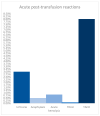Exploring the Intersection of Blood Transfusion and Same-Day Computed Tomography Imaging: An Overview of Clinical Risks and Practices
- PMID: 39410606
- PMCID: PMC11475811
- DOI: 10.3390/diagnostics14192201
Exploring the Intersection of Blood Transfusion and Same-Day Computed Tomography Imaging: An Overview of Clinical Risks and Practices
Abstract
The use of transfusions, whether involving whole blood or specific blood components, is essential for managing various clinical conditions. Many cases are acute, often requiring post-transfusion imaging evaluation. While there is no absolute contraindication for chest imaging following blood transfusion, it should be approached cautiously. We conducted a comprehensive search across multiple databases and registries. Research studies were limited to full-text original articles, reviews, and case reports published in English, involved human subjects, and focused on the interplay between blood transfusions and contrast-enhanced imaging. Scientific analyses were excluded if they did not focus on transfusion practices in the context of imaging or failed to address issues such as hemoglobin thresholds, transfusion reactions, or the clinical implications of contrast agents. Our research fills this gap by emphasizing the need for a cautious, multidisciplinary approach to post-transfusion computed tomography (CT) scans, especially in the presence of contrast agents. This study calls for increased awareness of the heightened risk of complications, such as autoimmune hemolysis, when both procedures are performed together. New insights from our research recommend individualized assessments and close patient monitoring when combining these interventions. Nevertheless, patients need to be hemodynamically and clinically stable before undergoing CT. Discussions. Symptoms that develop within the first 24 h post-transfusion are classified as secondary post-transfusion reactions unless proven otherwise. The prevalence of side effects from same-day CT scans and blood transfusions is challenging to quantify, as few studies focus on this combination. Transfusions and contrast-enhanced CT scans share overlapping adverse reactions and carry significant risks. Acute hemolytic red blood cell transfusion reactions are among the most frequent side effects, with a prevalence of 1:12,000-38,000. Conclusion. Our study contributes new insights to the literature by filling the gap concerning the interplay between transfusions and contrast media, paving the way for more informed clinical protocols to enhance patient safety.
Keywords: blood cell component; contrast agent; contrast-enhanced CT; transfusion.
Conflict of interest statement
The authors declare no conflicts of interest.
Figures


References
-
- Dynamed. [(accessed on 30 December 2023)]. Available online: https://www.dynamedex.com/condition/transfusion-reactions#GUID-E1D511FC-....
-
- Trentino K.M., Farmer S.L., Leahy M.S., Sanfilippo F.M., Isbister J.P., Mayberry R., Hofmann A., Shander A., French C., Murray K. Systematic reviews and meta-analysis comparing mortality in restrictive and liberal haemoglobin thresholds for red cell transfusion: An overview of systematic reviews. BMC Med. 2020;18:154. doi: 10.1186/s12916-020-01614-w. - DOI - PMC - PubMed
-
- Lee B.H., Lee K.S., Kim H.I., Jung J.S., Shin H.J., Park J.H., Hong S.C., Ahn K.H. Blood transfusion, all-cause mortality and hospitalization period in COVID-19 patients: Machine learning analysis of National Healt Insurance Claims data. Diagnostics. 2022;12:2970. doi: 10.3390/diagnostics12122970. - DOI - PMC - PubMed
Publication types
LinkOut - more resources
Full Text Sources
Miscellaneous

